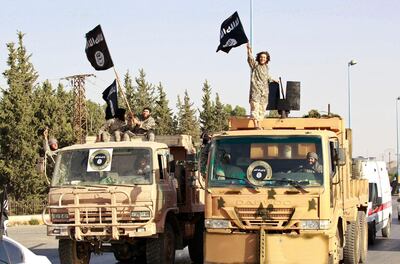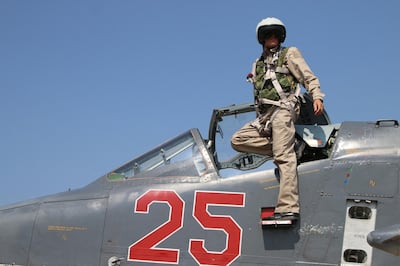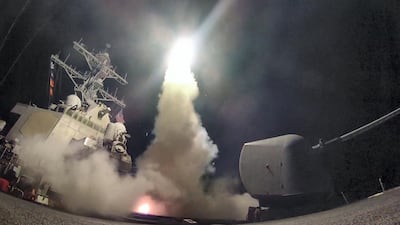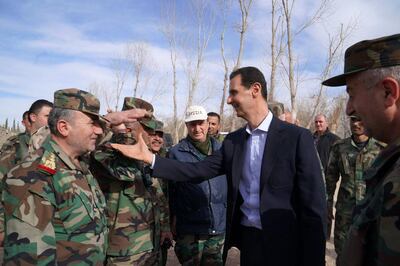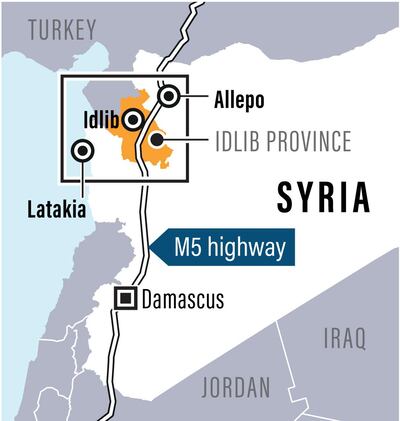It has been 10 years since the start of the war in Syria, but the conflict grinds on with little sign of ending.
Even if the regime of Bashar Al Assad, who has often portrayed himself as a bastion of resistance against the imperialist West, manages to retake Idlib province – the last stronghold of Syria's rebels – the country is now in ruins and bogged down in economic misery.
More than 300,000 people have died and 11 million have been displaced. Many other casualties remain undocumented.
The war's intensity has been driven by the growing realisation among the opposing sides that defeat means near-certain death.
Foreign powers spent the conflict's first few years lavishing money, weapons and mercenaries on their chosen side.
Mr Al Assad has succeeded in recapturing most of the major cities and provinces he lost during the war.
But he presides over a damaged, depopulated country that will be suffering for many years to come. Reconstruction will cost hundreds of billions of dollars.
To many observers, the war may seem like a long blur of violence and suffering but some pivotal events stand out:
2011: peaceful protests met with regime gunfire
In early 2011, Syrians scrawled "Your turn, doctor!” on walls in the southern city of Deraa. A reference to Mr Al Assad, who is a qualified ophthalmologist, the slogan was inspired by anti-regime uprisings in Tunisia, Libya and Egypt. Syria's regime detained the children responsible and tortured them. Anti-regime protests spread across the country with demonstrators demanding that Mr Al Assad step down. The regime responded with mass arrests, kidnappings and increasingly, gunfire.
2012: opposition takes up arms
Although the first clashes between government forces and opposition groups began as early as the summer of 2011, sustained violence resembling a civil war did not start until 2012 when cities such as Hama came under sustained artillery bombardment. The Free Syrian Army, formed by regime defectors, soon found itself among a collection of different allied factions, many of them with extremist sympathies. Backed by regional powers, these groups started seizing vital cities that were left largely undefended by government forces.
By mid-2012, the regime’s aircraft started dropping barrels laden with explosives on its own people in rebel-held areas, supplementing this devastating bombardment with heavy artillery attacks.
2013: Iran and Lebanon’s Hezbollah defend Assad
As regime forces came under increasing pressure – a number of army bases fell to the rebels in the rural north in late 2012 and early 2013, Lebanon’s Hezbollah openly sent its fighters to support Mr Al Assad.
The Islamic Revolutionary Guard Corps also sent advisers and – reportedly – weaponry to support its beleaguered ally.
But it wasn't just the rural north and east where the rebels were gaining ground. Fighting soon raged in the suburbs of Damascus, where the regime was just as violent in its methods as it was in cities such as Hama, Homs and Aleppo.
UN inspectors confirmed that the nerve agent sarin was used in an attack on the Ghouta agricultural belt around Damascus in August 2013.
Former US president Barack Obama put military action against the Assad regime on hold and vowed to pursue diplomacy to remove the government's chemical weapons.
2014: the rise of ISIS
In June 2014, ISIS announced it controlled a vast area of Syrian territory, with Raqqa as its capital.
The US and its allies in the West and the wider region shifted focus from removing Mr Al Assad to fighting the extremists of ISIS, although the Al Qaeda-linked Jabhat Al Nusra came to dominate Idlib province.
By 2014, ISIS had seized territory in Syria and Iraq and proclaimed a so-called caliphate.
It survived on oil sales, kidnappings, robbery and extortion, as well as illicit financial transfers from wealthy foreign donors. Slowly, international efforts worked to close down these channels of funding.
2015: Russia changes the conflict
In September 2015, Russia sent weapons, military advisers and mercenaries to prop up Mr Al Assad's Iran-backed government forces. The Russian intervention, bringing heavy firepower to back up the regime's crumbling air force, was a game changer. But it led to another huge wave of refugees.
Russia’s infamous air strikes bombed entire cities flat, often using the double-tap technique, where the first air strike hits and a second one follows within minutes to kill whomever comes to the rescue.
In 2015, an image of a Syrian Kurdish boy called Alan Kurdi lying face down on a Turkish beach after a boat capsized in the Mediterranean highlighted the Syrian refugee crisis. Millions took the deadly sea route between Turkey and Greece in a desperate attempt to reach Europe. The war forced half of Syria’s prewar population of nearly 22 million to flee their homes within the country or go further afield, with millions pouring into Europe, Turkey, Lebanon, Jordan and Egypt.
2016: chlorine gas
Syrian rebels and activists accused the regime of using chlorine in gas attacks on Aleppo after graphic footage emerged on social media of people with severe breathing difficulties.
The UN said a chlorine attack would amount to a war crime.
2017: US military strikes after chemical weapons used again
Chemical weapons were used in the strategic northern city of Khan Sheikhoun in April 2017, which UN experts blamed on the Syrian government.
Up to 100 civilians were thought to have died and the attack prompted military strikes by the Donald Trump administration.
But for the rebellion, which by now was riven with extremist infighting and pounded by Russian air strikes, there was little hope left. This did not stop increasing involvement from Turkey, Russia and Iran.
The conflict continued to spiral out of control, with Russian and Turkish forces clashing, Israeli air strikes hitting Syrian forces and even clashes between Shiite militias and US forces. In May 2017 for example, Turkey threatened to bomb US forces who were embedded with allied Syrian Kurdish fighters in the campaign against ISIS.
Fearing uncontrollable conflict, Russia and Turkey reached a de-escalation agreement in flashpoints, including the strategically important Idlib province which is on the border with Turkey.
2018: regime controls most of the country
Russian air power helped the regime regain control over most of the country. By mid-2018, the regime retook major cities and areas, chiefly Aleppo and large patches of the countryside and suburbs of Damascus, and then Deraa, known as the cradle of the Syrian revolution.
Russia and Turkey reached an agreement in September 2018 to avert a full-scale regime operation to recapture Idlib. The Sochi accord called for a 25-kilometre demilitarised buffer zone. The rebel factions were required to pull their heavy weapons out of the zone, and extremists in the province, like Al Qaeda-linked Hayat Tahrir Al Sham were told to withdraw altogether from the zone.
2019: the defeat of ISIS
The Kurdish-led and US-backed Syrian Democratic Forces declared the self-proclaimed ISIS "caliphate" defeated after the militants' capitulation in their last stronghold, the eastern village of Baghouz. The US, however, still believes that the extremist group has many sleeper cells in Syria and elsewhere in the Middle East.
Throughout the years of the conflict, there were several peace initiatives, backed at various points by the UN, the US and Russia in cities like Geneva and Astana, the Kazakh capital, and Sochi in Russia. But all these peace efforts have failed to stop the killings, torture, bombings and displacement.
Syrian opposition forces withdrew from the strategic town of Khan Sheikhoun, deep in Idlib. The city lies along the M5 road, which is the main motorway through Syria from north to south, linking Damascus, Homs and Aleppo.
2020: the battle for Idlib continues
Despite the Covid-19 pandemic, government air strikes and ground operations continued in 2020, driving almost a million civilians from their homes in Idlib province since December.
The UN says this is the biggest single displacement of Syria’s 10-year war and has warned that a full-scale battle – promised by the regime to recapture Idlib – could result in a new bloodbath.


